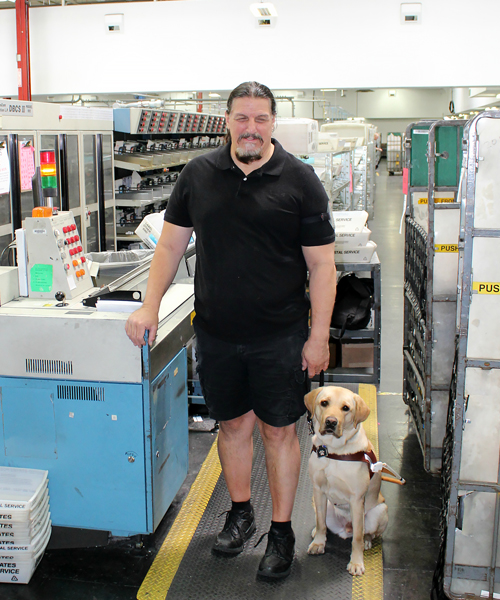The San Diego mail processing clerk who was recently honored by a publication for people with disabilities has a new best friend.
Garfunkel, a yellow Labrador, guides Frank Facio, who is blind. The dog helps Facio perform his duties, including working on delivery barcode sorting machines.
“Me wanting to go on the workroom floor was a big deal. I thought that one of the only ways I can do this is with a guide dog to help me navigate and keep me safe,” said Facio, who was honored by Careers & the disABLED magazine in the spring.
Guide dogs have helped Facio since he lost his sight in 1992. He received Garfunkel a few months ago, shortly after the death of his longtime service dog, Romano.
As Facio pulls the sorted mail and loads mail trays, Garfunkel waits by his side, then guides him around the workroom floor throughout his shift.
“Having Garfunkel helps Frank be independent,” said Teresa Navarette, a disability compliance specialist with the USPS National Disability Programs Office. “Service animal accommodations allow individuals with disabilities to enjoy equal benefits and the privileges of employment.”
Garfunkel was trained at the Boring, OR, campus of Guide Dogs for the Blind, an organization that ensures dogs are accustomed to everyday situations like going inside stores and restaurants, walking in crowds and helping individuals who are blind do their jobs.
Facio wants people to know that service animals are not like other dogs: They are working and should not be distracted.
“It’s best to ask if you can pet them,” he said. “In a crowded area, for example, I need Garfunkel to be focused. If I allow everyone to pet him, he will see someone approach and want to walk to them because he’s used to being petted.”
Facio loves his job and is grateful Garfunkel is there to help.
“If not for these guide dogs, I wouldn’t know where I’d be right now, or if I’d even be at the Post Office,” he said.
